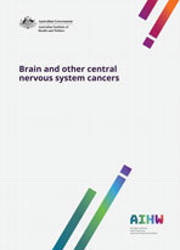Summary
Brain and other central nervous system cancers is the first national report to present comprehensive data specific to brain and other central nervous system (CNS) cancers in Australia. This report provides an overview of brain and other CNS cancer, its risk factors as well as key summary measures including incidence, mortality, treatment, survival, prevalence and years of life lost due to death or disability. It also includes a ‘spotlight’ section which presents available data for non-malignant brain and other CNS tumours.
While brain and other CNS cancers are rare, they have a large impact
It is estimated that in Australia in 2017, 2,076 new cases of brain and other CNS cancer will be diagnosed and 1,477 people will die from this disease. On average, 6 cases of brain and other CNS cancer will be diagnosed each day and 4 people will die each day from this disease. Reflecting its impact, although brain and other CNS cancer is the 17th most commonly diagnosed cancer and represents 1.5% of all cancers diagnosed, it was the 6th leading cause of cancer burden. Australians lost 35,662 disability-adjusted life years due to brain and other CNS cancer, and most of the burden (96%) was due to dying prematurely.
In 2009–2013, Australians diagnosed with brain and other CNS cancer had on average a 25% chance of surviving for five years compared with others in the general population, whereas this figure was 68% for all cancers combined. This rate has remained steady, with no clear improvement in survival over the last 30 years. The more common types of brain and other CNS cancer have the lowest survival rates.
Leading cause of cancer burden in children
It is estimated that in 2017, 110 cases of brain and other CNS cancer will be diagnosed in children aged 0–14 and that 38 children will die from these cancers. Brain and other CNS cancer was the second most commonly diagnosed cancer in children (15% of all cancers) after leukaemia and the 7th leading cause of death from all causes. It was the second most common cause of cancer death after leukaemia, and the leading cause of cancer death in children aged under 10.
In children, brain and other CNS cancer was the leading cause of cancer burden, accounting for 29% of the burden in boys and 33% of the burden in girls. Most of this burden (98%) was due to dying prematurely.
Non-malignant brain and other CNS tumours cause significant morbidity and mortality
Unlike most non-malignant tumours, non-malignant tumours of the brain and other CNS cause high rates of morbidity and mortality. In 2013, there were 1,029 new cases of non-malignant tumours of the brain and other CNS recorded in Victoria, Queensland and Western Australia (the jurisdictions for which cancer incidence data were available). In 2015, 279 people died from these diseases in Australia. In 2011, Australians lost 5,729 disability-adjusted life years due to non-malignant brain and other CNS tumours, and most of the burden (75%) was due to people dying prematurely.
Preliminary material: Acknowledgments; Abbreviations; Symbols
1 Introduction
- Defining brain and other CNS tumours
- Brain cancer risk factors
- Scope of this report
2 Incidence
- Brain and other CNS cancer
- Site
- Histology
3 Treatment
- Number of hospitalisations
- Hospital surgical procedures
- Chemotherapy
- Radiotherapy
4 Survival
- Brain and other CNS cancer
- Site
- Histology
5 Survivorship
- Survivorship population
- Survivorship experience
6 Burden of disease
- Brain and other CNS cancer
7 Mortality
- Brain and other CNS cancer
- Site
- Histology
8 Spotlight on non-malignant tumours of the brain and other CNS
- Incidence
- Survival
- Burden of disease
- Mortality
Appendixes:
Appendix A: Additional tables
Appendix B: Defining brain and other CNS cancer
Appendix C: Defining brain and other CNS cancer hospitalisations
Appendix D: Data sources
End matter: Glossary; References; List of tables; List of figures; Related publications



